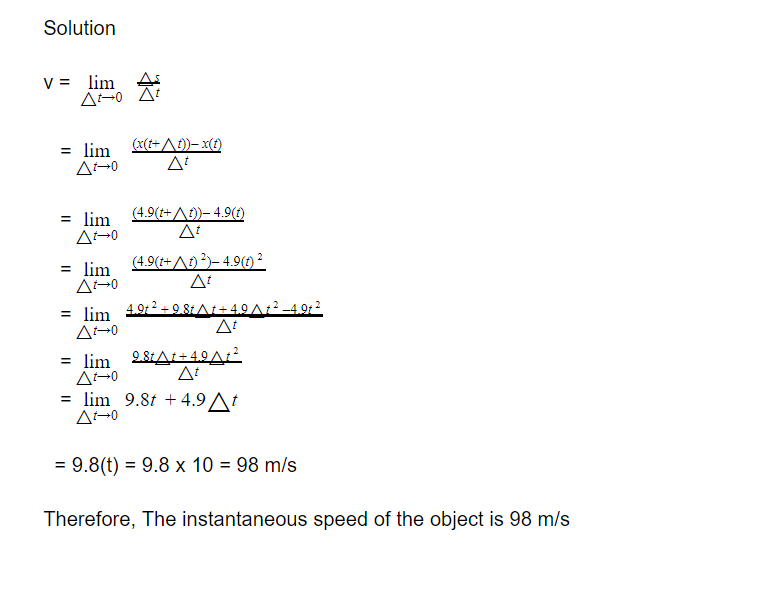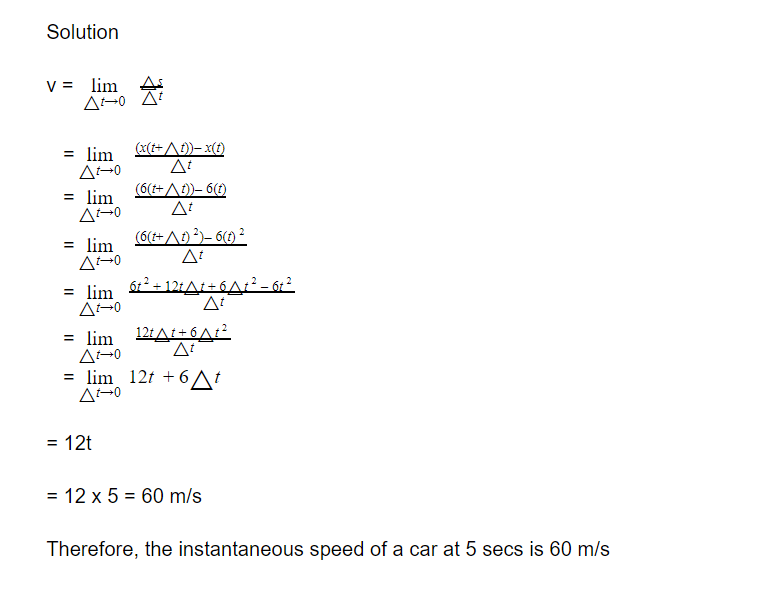In everyday physics, speed and velocity play an integral part to calculate how slow or fast a body moves. It helps to judge the time required for work and hence, helps plan the day accordingly. These concepts are some of the fundamental concepts which help in making some tasks easier.
What is Speed?
The ratio of distance travelled to the time required to travel that distance is defined as speed. Speed is a scalar number since it has just one direction and no magnitude. There are 4 types of Speed – Uniform Speed, Variable Speed, Average Speed and Instantaneous Speed.
Instantaneous Speed is calculated when the time is very small. Hence, it helps to figure out the speed at that particular moment.
Speed of any object is determined by
Speed = Distance/Time
Definition of Instantaneous Speed
An average speed for a particular time interval is equal to the total distance travelled divided by the entire time taken. As the time interval approaches zero, the distance travelled approaches zero. The distance-to-time ratio has a non-zero limit, which is referred to as the instantaneous speed. The magnitude of instantaneous speed is the magnitude of instantaneous velocity. It has the same magnitude as instantaneous velocity but has no direction.
In layman’s terms, an object’s instantaneous speed is the speed of an object at a specific moment (instant) in time while its speed is constantly changing.
Instantaneous speed is an important notion since it allows us to determine the speed of a body at any given time.
Instantaneous speed formula
Instantaneous speed is an important notion since it allows us to determine the speed of a body at any given time. The formula is determined by –
Speed(i) = dsdt where,
ds = distance travelled at a moment
dt = time taken
Speed(i) = Instantaneous Speed
Unit of Instantaneous Speed
The Unit of Instantaneous speed is similar to Speed. In the SI system, the Units are given as m/s. In the CGS system, the speed is calculated in cm/s.
Instantaneous vs Average Speed
- When an object is constantly moving, Speed calculated at any instant of time is called instantaneous speed.
- The average speed of an object is defined as the ratio of the overall distance travelled by the object to the whole time occupied by the object.
- For example – The speedometer of vehicles describes instantaneous speed. Whereas, we can calculate the displacement of an object by dividing the total distance w.r.t time.
Instantaneous vs Uniform Speed
- When an object is constantly moving, Speed calculated at any instant of time is called instantaneous speed.
- If an object travels the same distance in the same amount of time, it’s time speed graph is a straight line parallel to the time axis, indicating that it is moving at a uniform speed.
- A car driving at a steady speed on a straight route is an example of uniform motion.
Instantaneous vs Variable Speed
- When an object is constantly moving, Speed calculated at any instant of time is called instantaneous speed.
- When an object travels uneven lengths in an equal amount of time, it is said to be moving at a non-uniform pace.
- The motion of a bike or car on busy roads can be considered as an example of variable speed.
Difference between Instantaneous Speed and Instantaneous Velocity
Instantaneous speed | Instantaneous velocity |
The magnitude of instantaneous velocity is known as instantaneous speed. | The change in position that occurs with a minor change in time is known as instantaneous velocity. |
It is defined as a scalar quantity | It is defined as a vector quantity |
Instantaneous speed formula is given by Speed(i) = dsdt | Instantaneous velocity formula is given by |
Instantaneous Speed Examples
Example 1
When an object is dropped and gravity acts on it, the position of the object changes according to the function x(t) = 4.9t2, where x(t) is in metres. Using the Instantaneous Speed Formula, what is the instantaneous speed at t = 10.0 sec?

Example 2
An automobile comes to a complete halt at a traffic light before continuing on a straight route. The function x(t) = 6t2 determines the car’s distance from the light. At t = 5.00 s, what will be the instantaneous speed?

Example 3
The displacement of a particle is provided by the expression x(t) = 10 t2 – 5t + 1. Calculate the instantaneous speed of the object at time t = 3s.

Conclusion
Instantaneous speed is an important concept which deals with various real life applications. Knowing the instantaneous speed of an object helps us in determining various related factors and can be used in different utilities.
 Profile
Profile Settings
Settings Refer your friends
Refer your friends Sign out
Sign out






